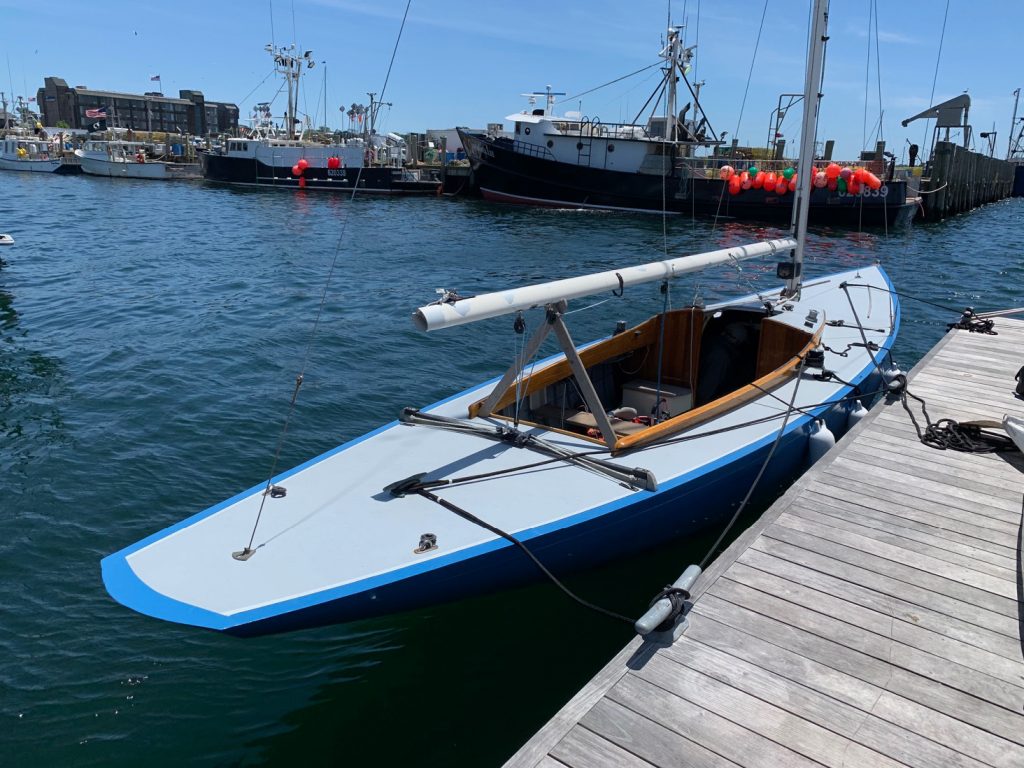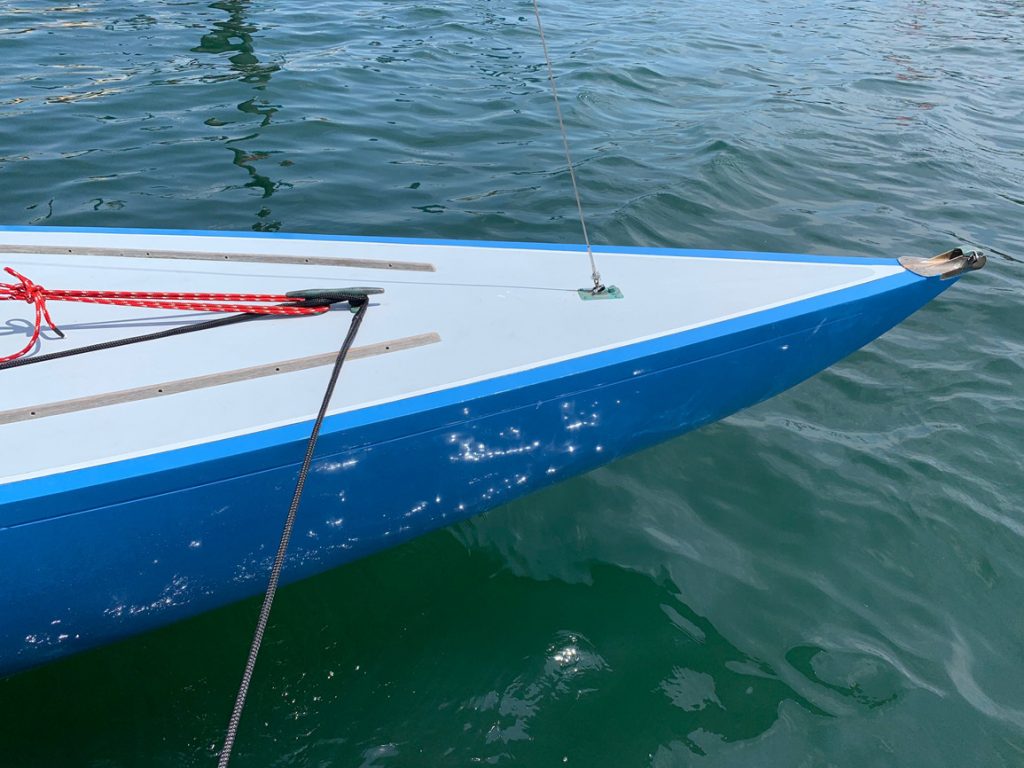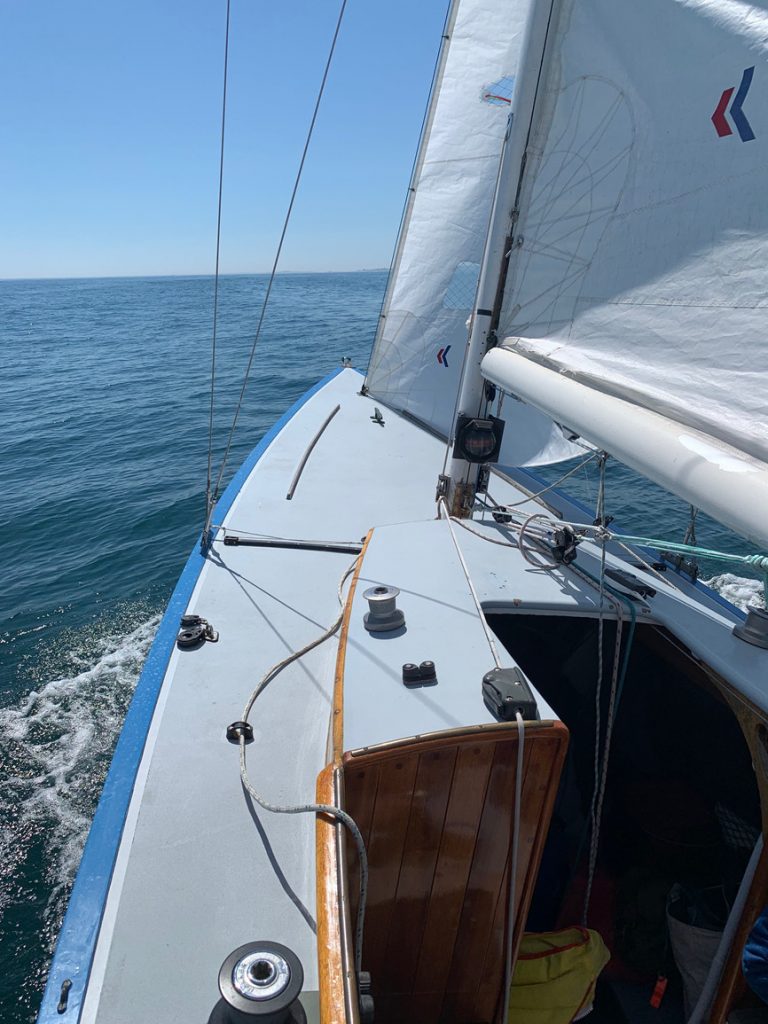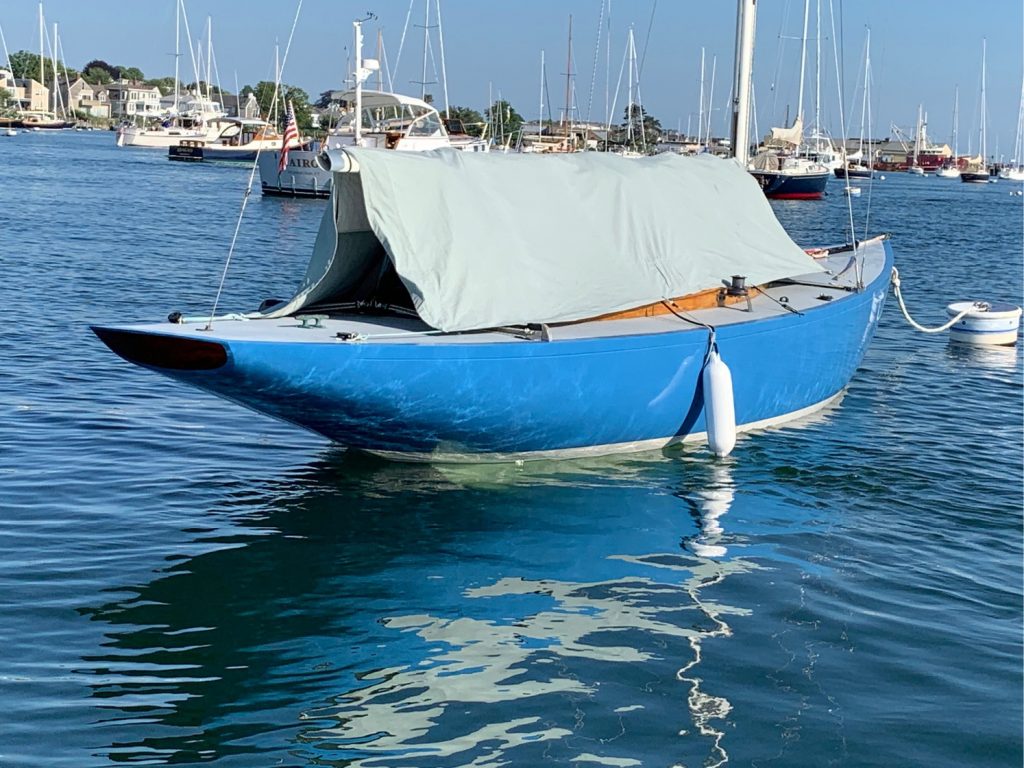Jim, Clem (and Tom’s) Wonderful IOD Adventure
Story and photos by Tom Darling

Etesian launched at Safe Harbor Newport Shipyard © conversationswithclassicboats.com
I told him not to do it. In fact, I begged him to reconsider. In February 2021, my good sailing friend of forty years, Clem Wood, called to ask my opinion on his pending choice of a new boat for his Stonington, Connecticut syndicate to replace the J/70 that they’d sailed the prior six years. I had to bite my tongue. He was talking about buying a 34-foot wooden boat built in 1959.
The purchase price was mid-four figures, a bargain. It would cost low five figures for a new rudder and an entire exterior makeover. It would be ready to sail in June 2021. Having sailed wooden boats beginning with a 1960 Blue Jay, #2062, I understood but didn’t have the heart to tell Clem he was crazy. I just resolved to be a helpful sailing friend.
The boat in question is the International One Design, known worldwide, at least in North America and Scandinavia, as the IOD. It has been sailed by the Who’s Who of Sailing: Shields, Bavier, Knapp, Mosbacher, on and on. It is thirty-three and a half feet long with an overall weight of 7,250 pounds, give or take hundreds. For those that sail it religiously, it is the It Boat. In the words of the late Jim Bishop, Sr., a longtime member of the Long Island Sound fleet who contributed countless hours and dollars to revitalizing the class, “the IOD is a Stradivarius of a boat, as far as I’m concerned.”
Recalling our histories of the International Six Metre (windcheckmagazine.com/article/a-century-of-sixes/), the IOD was the product of the 1930s and progeny of a famous Bermudian Six, Saga, built by Norwegian designer and builder Björn Aas. Simply stated, the IOD was a one-design Six Metre.
One of the long-term practitioners of the IOD arts, Henrik Anderson, owner of many Sixes including Olin Stephens’ epic 1938 Djinn, summed it up. When a child was asked to draw a boat, it was the profile of a Six Metre that appeared on the paper. A Six of any variety epitomized “what a boat should look like.”
The Boat
There is no more stunning view than the gleaming topsides of an IOD bobbing at the mooring. The grace of the sheer, the towering rig, the diminutive Six-Metre stern capable of taking no more than a 7-letter name, are unique in North American waters. Perhaps only 8 Metres, like Bruce Dyson’s Pleione or the pair of 8s at Oakcliff Sailing in Oyster Bay, Defender and Invader, can match this maritime panache.
Looking deeper into the design, we consulted the glossy hardcover book published by the IOD World Class Association for its 75th year Jubilee in 2011. This limited edition features the history of the class, a profile of each of the active fleets, and (as with the website of the International Six Metre Class) a provenance of every boat known to exist.
Oyster Bay 1959: The Sail Training Center to Fishers Island 1980s
My friend was acquiring a boat that dated back to 1959, one that involved yet again a notable figure from Six Metre history. Herman “Swede” Whiton was the only three-time American gold medal winner in Olympic Sailing, in both the Six Metre and his own creation, the 5.5 Metre, itself a Six Metre hull with an IOD-style rig.
From a wealthy industrial family, Whiton first climbed into an Olympic Six Metre cockpit in the 1928 Games, in his 20s. Part of the famed British American Cup (“BAC”) team of 1931 with a boat of his own design, Indian Scout, he competed throughout the Six Metre Golden Age of the 1930s, winning every cup from Bermuda to the Scandinavian Gold Cup. He commissioned famous Six Metre designs like Llanoria that were the first metre boats to revive the British American Cup and North America’s longest standing trophy, the Seawanhaka Cup for match racing.
It was no surprise that in 1959 Whiton would underwrite the creation of a novel form of sailing school, for established racers, like a Top Gun aviation school for sailors, with a faculty comprising the stars of his day: skippers, sailmakers, designers, builders. The boldfaced names on the faculty were well known: Knapp, Shields, Etchells, Ratsey, Bavier, Mosbacher, Ulmer.
Whiton ordered ten 5.5 Metres and eight IODs to serve as the “Top Gun” yachts for the elite community sailing fleet (an operational model that Oakcliff Sailing employs today with its Match 40s and Farr 40s). The blue boat had #7 on the sail. This was my friend’s bride boat to be, named Golf for the signal flag of the seventh letter of the alphabet.
How did Golf get to my friend’s home waters near Stonington? Golf was one of a pair of Whiton boats imported to isolated Fishers Island, a windswept combination of rocks ringed by current, during the 1980s. Her odyssey is a story of unusual sailing characters, including one Steve Cook and one Boots Parker, herself a member of the extended Du Pont family that has colonized this island for many years.

Above: The restoration by Jim Thompson, Jr. is spectacular. © conversationswithclassicboats.com
Boots Parker and the founding of the Fleet
In John Rousmaniere’s book on The Fishers Island Yacht Club, another must for your coffee table (and the model for the book being published by Seawanhaka Corinthian YC for its 150th anniversary this year), he traces the lineage of the progression of keelboat classes designated as the local design of choice. Those boats started with the Quincy Adams 17 and the first strip-planked Luders 16s during the 1930s. First mention of the IOD is in the 1980s.
I quote John from his section on Sailing at Fishers: “The search for a new racing fleet went unsatisfied for more than a decade. Ensigns, Solings, Etchells 22s, Watch Hill 15s – all are good boats, and all were tried, considered, and rejected as the Fishers Island Yacht Cub new class because none of them had the classically sleek appearance that had been deemed necessary for a Fishers racing class since the Herreshoff boats and the Luders 16 came to West Harbor in the 1920s and ‘30s. The long search finally ended almost accidentally.”
John goes on to tell this story: “The first wooden IOD on Fishers was the import of one Steve Cook who in 1983 found a wooden boat in Long Island Sound with an asking price of $3,000.” (How much did today’s Golf trade for? Surprise, not a big difference.) As the story goes, Cook offered $6,000 and sailed the boat, aptly named Preemptive Bid, the 90 miles east to West Harbor.
The rest of the creation myth of IODs on Fishers revolves around one of the island’s intrepid female sailors, Boots Parker. Steve Cook’s boat was sitting in the boat yard the next spring when one Ester Riegel Parker Wright, aka “Boots,” saw Boat #1 and was reported to say, “What’s that? I want one.” Boots hearkened back to her youth and J boats. “I thought the IOD looked just like a small J Boat. I thought that’s what a sailboat should look like.” (p 123 Rousmaniere Sailing at Fishers)
But Steve Cook wouldn’t sell. Boots had to look elsewhere. It was Boots’ role as Pied Piper over the next five years that created the fleet.” (p 123) She bought a boat in terrible shape and “learned how to repair it in tutorials, then bought two more (boats) which created the base of the Fishers fleet.” One of those boats was Golf #7.
Subsequent additions to the Fishers fleet came in the form of syndicates. John Burnham, former editor of Sailing World and one of the entrepreneurs behind Phlotilla, an online sailing portal in Newport, RI, came to the IOD together with his group, the Norwegian Wood syndicate. This syndicate model spread the cost of maintaining old wooden boats, and guaranteed oneself a crew base in the face of work and other leisure commitments. After ten years, by the late 1990s, ten IODs, half sailing as syndicates, were doing thirty races a summer. That’s classic boat success.
My friend Clem had a ready-made syndicate. They had been three of a four-person J/70 team for five seasons. Now the opportunity came for a gentlemen’s boat. And they seized it.

Left: Forty miles, eight hours… © conversationswithclassicboats.com
The Boatwright
Golf came with her very own Boatwright. Meet Jim Thompson, Jr., Marine Carpenter. The man was poised to work his wooden boat magic. This was Jim’s third restoration of an IOD. The first was his father’s boat, Allegra, named for one of Long Island Sound’s pioneering helmswomen, Allegra Mertz. His second took ten years in a driveway in Mattapoisett, across the harbor from New Bedford. There he and Charlie van Vorheis, a top skipper in the class, reconstructed Charlie’s boat Jester and produced – albeit slowly – a yellow rocketship of an IOD.
I did my best to steer my friend to fiberglass, but the lure of the wood boat won out. My ongoing sense of responsibility caused me to accompany Clem to the site of the renovation at the end of April.
Jim the Boatwright had a mission: to whip 7,240 pounds of oak, mahogany and lead into racing trim. The raw materials were the best planks there are, and lead…lots of lead like any self-respecting International Rule boat.
His new patient was parked in Middletown, north of greater Newport, in a back garage shrouded with plastic behind an auto body shop. His sidekick was a young boat restorer named Felix, who had done his apprenticeship at the IYRS School of Technology & Trades in Newport, the local center for wooden boat surgery, and then in a Maine wooden boatyard.
When we visited in April 2021, Golf was sanded naked and looked like a boat in the dentist’s chair. There are about 2,200 fastenings in the hull of an IOD, each with a mahogany disk or ‘bung’ covering the screw. To refasten the hull of the boat requires pulling out every loose bung, routing out between the mahogany planks, and replacing where necessary. Fortunately, no new planks were required.
When we arrived, Jim was contemplating Felix’s work on pulling one pesky bung. Jim described the intricacies of splining and its contribution to achieving a smooth racing surface. In layman’s terms, as smooth as a baby’s bottom. Jim explained what looked like an IOD bottom molting was really this expert technique of splining. This is the cosmetic surgeons’ trick to smooth and tighten an IOD underbody. Between the mahogany planks he drives out the old oakum and drives in long strips of cedar. The plugged hull is then planed down and multiple layers of fairing compound applied and sanded before the paint job. The result is a stunning eggshell-like hull surface. The paint is the boat’s original color.
The completed rebuild is the work of an art restorer. She could have been a Ming vase or an Expressionist painting, but she’s a wood boat, made mainly of oak and mahogany. It is fitting that #7 received a new classical name, Etesian, after a Greek wind. For Jim Thompson, that is the ultimate satisfaction: to make classic wood watercraft whole again. Jim’s the Antique IOD Doctor. What’s it like to sail a precious antique? We were about to find out.

Built 1959. Redone 2021. To follow this beauty’s progression from bare wood to jewel-like topside and smooth white bottom, check the photo gallery of our podcast “The IOD Reborn” at ConversationswithClassicBoats.com. © conversationswithclassicboats.com
The Launch
Good to his word, Jim called a week before the June 17 launch and asked us to be present on the 18th. When we arrived with a mid-sized Audi stuffed to the gills with equipment, food, coolers, and the boom strapped and duct taped to the roof, we looked like refugees fleeing a war zone. The former owner, Bill Reed, had driven me in his Smart car up the rickety Route 1 along the Rhode Island coast, reminiscing on past regattas.
When we saw the boat, in a breathtaking blue, she was sitting on the float at Safe Harbor Newport Shipyard across from Whisper, a huge Ron Holland megayacht with three 20-foot containers of gear up in the parking lot. People came by, yachties working on the dozen megayachts nearby, to admire. Clem was as proud as the grandfather he had recently become.
Our next issue was the weather, which looked odious for our planned departure. As we rigged and loaded the boat on Friday, we were mentally prepared to delay. A menacing cold front was lurking. We would wait to Sunday if necessary. We would sit and tinker, then went to lunch in Bristol. The storms that ripped across Rhode Island at 5pm Saturday confirmed our suspicions. Far better to be at the dock.
The Maiden Voyage
Sunday dawned dry and lovely. The mega yacht dock was quiet, yachties asleep after their night at the Candy Store and Black Pearl of Newport waterfront fame.
At 8:24 we pushed off the Newport Shipyard dock, tacked to avoid the fishing boat pier and threaded our way in a 5-knot west-southwest breeze past the 12 Metres anchored off Goat Island. Count them: Columbia, Nefertiti, American Eagle.
We tacked west to pass Fort Adams and head in the still ebbing south current across the channel. Escaping the evil mix-master of Castle Hill’s tides and currents, we tacked southwest into the light seabreeze and slipped upwind toward Point Judith, eight miles away. At 11:15, right on schedule, we tacked west and headed for the Rhode Island beach shore to avoid the east-flowing current. Point Judith was a maelstrom of fishing boats, lobster pots and current headed north. Quiet returned as we slipped toward the south facing Rhode Island shore on our waypoint at Watch Hill Passage, past beaches of hopeful sunseekers.
Ghosting with the fair current, we were taken with the slippery, quiet charm of a brand-renewed wooden classic. There was not but a cup of water in the bilge. All is well at eight bells as we closed on Watch hill Passage at 5 knots. “The most fun you can have in a boat going four and a half knots,” Jim remarked. We were having it. We ran the gauntlet at Gangway Rock, picked up the boiling flood current and headed to Stonington Harbor.
On schedule for an on-time arrival, we picked up the mooring at 17:25. On the Wadawanack Club’s last available mooring, the farthest north, Etesian had her back to the whir of the Amtrak trains on the Northeast corridor tracks, twenty boatlengths away.
Heh, this is easy, right? Figure forty miles, eight hours. The IOD Adventure of Clem and Jim had become the Extraordinary IOD Adventure of Clem, Jim, and Tom. It was magical. Hail Etesian! ■
Tom Darling starts his second year of his podcast Conversations with Classic Boats, which is available on Apple Podcast, Google Podcast and Spotify as well as the website at conversationswithclassicboats.com. You can also hear episodes via SpinSheet, Scuttlebutt Sailing News, and WindCheck. Community sailing groups such as Sail Newport and New England Science & Sailing also distribute episodes of Conversations with Classic Boats.
